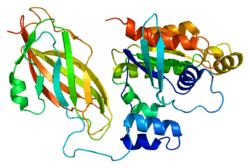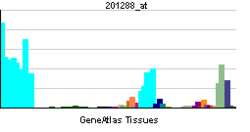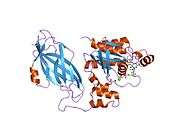ARHGDIB
| View/Edit Human | View/Edit Mouse |
Rho GDP-dissociation inhibitor 2 is a protein that in humans is encoded by the ARHGDIB gene.[3][4][5] Aliases of this gene include RhoGDI2, GDID4, Rho GDI 2, and others.[6]
Interactions
ARHGDIB has been shown to interact with VAV1[7] and Src.[8]
Gene family
RhoGDI2 (ARHGDIB) is part of a family of three members: RhoGDI1, RhoGDI2 (also known as RhoGDIB, D4-GDI or Ly-GDI) and RhoGDI3. RhoGDI1 is expressed in many organs and is the best studied member of the family.[9][10][11] RhoGDI2 was initially believed to be expressed specifically in blood forming cells,[4] but has subsequently been found to be highly expressed in a variety of other cell types as well.[12] RhoGDI3 is predominantly expressed in brain, lung, kidney, testis and pancreas,[13][14] and is targeted to specific parts of the cell such as the Golgi where it may play a role in transport or proteins in cells.[15][16]
Disease involvement
Despite a high degree of sequence similarity, RhoGDI1 and RhoGDI2 are very different in their binding affinities for specific GTPases,[17] and more importantly, in their roles in tumor formation and spread of tumor to other organs (the process of metastasis).[18] For example, RhoGDI2 functions as a suppressor of metastasis but not a tumor suppressor in bladder cancer cells,[12][19] while RhoGDI1 is a ubiquitous suppressor of tumor growth in all sites so far examined in bladder cancer models),[20] suggesting that their cellular functions must diverge to cause these differential effects.
While there are clear links between the alteration of RhoGDI2 protein levels and disease progression and/or metastasis in several types of cancer, the mechanistic underpinnings of the mode of RhoGDI2 action under carcinogenic cellular conditions are only now beginning to be understood. Evidence demonstrates that RhoGDI2 inhibits the endothelin axis and crosstalk with macrophages within the micrometastatic microenvironment to inhibit metastatic outgrowth.[21] As such, RhoGDI2 could prove important in the regulation of tumor dormancy. Targeting this axis with orally available endothelin receptor antagonists[22] may prove efficacious in mimicking the inhibitory role of RhoGDI2 by preventing macrophage infiltration into the micrometastatic niche.[23] Recent work has also determined that genetic and pharmacologic targeting of chemokine (C-C motif) ligand 2 (CCL2) also known as monocyte chemotactic protein-1 (MCP-1) or small inducible cytokine A2, its receptor CCR2 and pharmacologic ablation of macrophages can also phenocopy the effect of RhoGDI2 expression to prevent metastatic colonization of the lung67 and that RhoGDI2 is suppressor of versican, a protein that has been shown to promote cell migration[24] and metastasis in several tumor models.
In contrast to its role as a metastasis suppressor in bladder cancer, in breast, RhoGDI2 expression has been reported to be upregulated in cancer[25] and to promote invasion of breast cancer cells,[26] while another report found a biphasic expression pattern of RhoGDI2 in breast cancer with decreased expression correlating with lymph node metastasis.[27]
References
- ↑ "Human PubMed Reference:".
- ↑ "Mouse PubMed Reference:".
- ↑ Lelias JM, Adra CN, Wulf GM, Guillemot JC, Khagad M, Caput D, Lim B (March 1993). "cDNA cloning of a human mRNA preferentially expressed in hematopoietic cells and with homology to a GDP-dissociation inhibitor for the rho GTP-binding proteins". Proc Natl Acad Sci U S A. 90 (4): 1479–83. doi:10.1073/pnas.90.4.1479. PMC 45897
 . PMID 8434008.
. PMID 8434008. - 1 2 Scherle P, Behrens T, Staudt LM (September 1993). "Ly-GDI, a GDP-dissociation inhibitor of the RhoA GTP-binding protein, is expressed preferentially in lymphocytes". Proc Natl Acad Sci U S A. 90 (16): 7568–72. doi:10.1073/pnas.90.16.7568. PMC 47183
 . PMID 8356058.
. PMID 8356058. - ↑ "Entrez Gene: ARHGDIB Rho GDP dissociation inhibitor (GDI) beta".
- ↑ "Gene Cards: ARHGDIB".
- ↑ Groysman M, Russek CS, Katzav S (February 2000). "Vav, a GDP/GTP nucleotide exchange factor, interacts with GDIs, proteins that inhibit GDP/GTP dissociation". FEBS Lett. 467 (1): 75–80. doi:10.1016/S0014-5793(00)01121-2. PMID 10664460.
- ↑ Wu Y, Moissoglu K, Wang H, Wang X, Frierson HF, Schwartz MA, Theodorescu D (April 2009). "Src phosphorylation of RhoGDI2 regulates its metastasis suppressor function". Proc. Natl. Acad. Sci. U.S.A. 106 (14): 5807–12. doi:10.1073/pnas.0810094106. PMC 2667073
 . PMID 19321744.
. PMID 19321744. - ↑ DerMardirossian C, Bokoch GM (July 2005). "GDIs: central regulatory molecules in Rho GTPase activation". Trends Cell Biol. 15 (7): 356–63. doi:10.1016/j.tcb.2005.05.001. PMID 15921909.
- ↑ Dovas A, Couchman JR (August 2005). "RhoGDI: multiple functions in the regulation of Rho family GTPase activities". Biochem. J. 390 (Pt 1): 1–9. doi:10.1042/BJ20050104. PMC 1184558
 . PMID 16083425.
. PMID 16083425. - ↑ Garcia-Mata R, Boulter E, Burridge K (August 2011). "The 'invisible hand': regulation of RHO GTPases by RHOGDIs". Nat. Rev. Mol. Cell Biol. 12 (8): 493–504. doi:10.1038/nrm3153. PMC 3260518
 . PMID 21779026.
. PMID 21779026. - 1 2 Theodorescu D, Sapinoso LM, Conaway MR, Oxford G, Hampton GM, Frierson HF (June 2004). "Reduced expression of metastasis suppressor RhoGDI2 is associated with decreased survival for patients with bladder cancer". Clin. Cancer Res. 10 (11): 3800–6. doi:10.1158/1078-0432.CCR-03-0653. PMID 15173088.
- ↑ Adra CN, Manor D, Ko JL, Zhu S, Horiuchi T, Van Aelst L, Cerione RA, Lim B (April 1997). "RhoGDIgamma: a GDP-dissociation inhibitor for Rho proteins with preferential expression in brain and pancreas". Proc. Natl. Acad. Sci. U.S.A. 94 (9): 4279–84. doi:10.1073/pnas.94.9.4279. PMC 20713
 . PMID 9113980.
. PMID 9113980. - ↑ Zalcman G, Closson V, Camonis J, Honoré N, Rousseau-Merck MF, Tavitian A, Olofsson B (November 1996). "RhoGDI-3 is a new GDP dissociation inhibitor (GDI). Identification of a non-cytosolic GDI protein interacting with the small GTP-binding proteins RhoB and RhoG". J. Biol. Chem. 271 (48): 30366–74. doi:10.1074/jbc.271.48.30366. PMID 8939998.
- ↑ Brunet N, Morin A, Olofsson B (May 2002). "RhoGDI-3 regulates RhoG and targets this protein to the Golgi complex through its unique N-terminal domain". Traffic. 3 (5): 342–57. doi:10.1034/j.1600-0854.2002.30504.x. PMID 11967128.
- ↑ Dransart E, Morin A, Cherfils J, Olofsson B (February 2005). "Uncoupling of inhibitory and shuttling functions of rho GDP dissociation inhibitors". J. Biol. Chem. 280 (6): 4674–83. doi:10.1074/jbc.M409741200. PMID 15513926.
- ↑ Gorvel JP, Chang TC, Boretto J, Azuma T, Chavrier P (January 1998). "Differential properties of D4/LyGDI versus RhoGDI: phosphorylation and rho GTPase selectivity". FEBS Lett. 422 (2): 269–73. doi:10.1016/S0014-5793(98)00020-9. PMID 9490022.
- ↑ Harding MA, Theodorescu D (May 2010). "RhoGDI signaling provides targets for cancer therapy". Eur. J. Cancer. 46 (7): 1252–9. doi:10.1016/j.ejca.2010.02.025. PMID 20347589.
- ↑ Gildea JJ, Seraj MJ, Oxford G, Harding MA, Hampton GM, Moskaluk CA, Frierson HF, Conaway MR, Theodorescu D (November 2002). "RhoGDI2 is an invasion and metastasis suppressor gene in human cancer". Cancer Res. 62 (22): 6418–23. PMID 12438227.
- ↑ Moissoglu K, McRoberts KS, Meier JA, Theodorescu D, Schwartz MA (April 2009). "Rho GDP dissociation inhibitor 2 suppresses metastasis via unconventional regulation of RhoGTPases". Cancer Res. 69 (7): 2838–44. doi:10.1158/0008-5472.CAN-08-1397. PMC 2701105
 . PMID 19276387.
. PMID 19276387. - ↑ Said N, Smith S, Sanchez-Carbayo M, Theodorescu D (January 2011). "Tumor endothelin-1 enhances metastatic colonization of the lung in mouse xenograft models of bladder cancer". J. Clin. Invest. 121 (1): 132–47. doi:10.1172/JCI42912. PMC 3007145
 . PMID 21183790.
. PMID 21183790. - ↑ Nelson J, Bagnato A, Battistini B, Nisen P (February 2003). "The endothelin axis: emerging role in cancer". Nat. Rev. Cancer. 3 (2): 110–6. doi:10.1038/nrc990. PMID 12563310.
- ↑ Said N, Sanchez-Carbayo M, Smith SC, Theodorescu D (April 2012). "RhoGDI2 suppresses lung metastasis in mice by reducing tumor versican expression and macrophage infiltration". J. Clin. Invest. 122 (4): 1503–18. doi:10.1172/JCI61392. PMC 3314474
 . PMID 22406535.
. PMID 22406535. - ↑ Wu Y, Siadaty MS, Berens ME, Hampton GM, Theodorescu D (November 2008). "Overlapping gene expression profiles of cell migration and tumor invasion in human bladder cancer identify metallothionein 1E and nicotinamide N-methyltransferase as novel regulators of cell migration". Oncogene. 27 (52): 6679–89. doi:10.1038/onc.2008.264. PMID 18724390.
- ↑ Moon HG, Jeong SH, Ju YT, Jeong CY, Lee JS, Lee YJ, Hong SC, Choi SK, Ha WS, Park ST, Jung EJ (September 2010). "Up-regulation of RhoGDI2 in human breast cancer and its prognostic implications". Cancer Res Treat. 42 (3): 151–6. doi:10.4143/crt.2010.42.3.151. PMC 2953778
 . PMID 20948920.
. PMID 20948920. - ↑ Zhang Y, Zhang B (June 2006). "D4-GDI, a Rho GTPase regulator, promotes breast cancer cell invasiveness". Cancer Res. 66 (11): 5592–8. doi:10.1158/0008-5472.CAN-05-4004. PMID 16740694.
- ↑ Hu LD, Zou HF, Zhan SX, Cao KM (June 2007). "Biphasic expression of RhoGDI2 in the progression of breast cancer and its negative relation with lymph node metastasis". Oncol. Rep. 17 (6): 1383–9. doi:10.3892/or.17.6.1383. PMID 17487395.
Further reading
- Aebersold R, Leavitt J (1990). "Sequence analysis of proteins separated by polyacrylamide gel electrophoresis: towards an integrated protein database.". Electrophoresis. 11 (7): 517–27. doi:10.1002/elps.1150110702. PMID 2226408.
- Shisheva A, Südhof TC, Czech MP (1994). "Cloning, characterization, and expression of a novel GDP dissociation inhibitor isoform from skeletal muscle.". Mol. Cell. Biol. 14 (5): 3459–68. doi:10.1128/mcb.14.5.3459. PMC 358710
 . PMID 7513052.
. PMID 7513052. - Adra CN, Kobayashi H, Rowley JD, Lim B (1995). "Assignment of the human GDID4 gene, a GDP/GTP-exchange regulator, to chromosome 12p12.3.". Genomics. 24 (1): 188–90. doi:10.1006/geno.1994.1601. PMID 7896279.
- Leffers H, Nielsen MS, Andersen AH, Honoré B, Madsen P, Vandekerckhove J, Celis JE (1994). "Identification of two human Rho GDP dissociation inhibitor proteins whose overexpression leads to disruption of the actin cytoskeleton.". Exp. Cell Res. 209 (2): 165–74. doi:10.1006/excr.1993.1298. PMID 8262133.
- Adra CN, Manor D, Ko JL, Zhu S, Horiuchi T, Van Aelst L, Cerione RA, Lim B (1997). "RhoGDIgamma: a GDP-dissociation inhibitor for Rho proteins with preferential expression in brain and pancreas.". Proc. Natl. Acad. Sci. U.S.A. 94 (9): 4279–84. doi:10.1073/pnas.94.9.4279. PMC 20713
 . PMID 9113980.
. PMID 9113980. - Takahashi K, Sasaki T, Mammoto A, Takaishi K, Kameyama T, Tsukita S, Takai Y (1997). "Direct interaction of the Rho GDP dissociation inhibitor with ezrin/radixin/moesin initiates the activation of the Rho small G protein.". J. Biol. Chem. 272 (37): 23371–5. doi:10.1074/jbc.272.37.23371. PMID 9287351.
- Gorvel JP, Chang TC, Boretto J, Azuma T, Chavrier P (1998). "Differential properties of D4/LyGDI versus RhoGDI: phosphorylation and rho GTPase selectivity.". FEBS Lett. 422 (2): 269–73. doi:10.1016/S0014-5793(98)00020-9. PMID 9490022.
- Illenberger D, Schwald F, Pimmer D, Binder W, Maier G, Dietrich A, Gierschik P (1999). "Stimulation of phospholipase C-beta2 by the Rho GTPases Cdc42Hs and Rac1.". EMBO J. 17 (21): 6241–9. doi:10.1093/emboj/17.21.6241. PMC 1170950
 . PMID 9799233.
. PMID 9799233. - Scheffzek K, Stephan I, Jensen ON, Illenberger D, Gierschik P (2000). "The Rac-RhoGDI complex and the structural basis for the regulation of Rho proteins by RhoGDI.". Nat. Struct. Biol. 7 (2): 122–6. doi:10.1038/72392. PMID 10655614.
- Groysman M, Russek CS, Katzav S (2000). "Vav, a GDP/GTP nucleotide exchange factor, interacts with GDIs, proteins that inhibit GDP/GTP dissociation.". FEBS Lett. 467 (1): 75–80. doi:10.1016/S0014-5793(00)01121-2. PMID 10664460.
- Kasper B, Tidow N, Grothues D, Welte K (2000). "Differential expression and regulation of GTPases (RhoA and Rac2) and GDIs (LyGDI and RhoGDI) in neutrophils from patients with severe congenital neutropenia.". Blood. 95 (9): 2947–53. PMID 10779444.
- Fauré J, Dagher MC (2001). "Interactions between Rho GTPases and Rho GDP dissociation inhibitor (Rho-GDI).". Biochimie. 83 (5): 409–14. doi:10.1016/S0300-9084(01)01263-9. PMID 11368848.
- Li X, Bu X, Lu B, Avraham H, Flavell RA, Lim B (2002). "The hematopoiesis-specific GTP-binding protein RhoH is GTPase deficient and modulates activities of other Rho GTPases by an inhibitory function.". Mol. Cell. Biol. 22 (4): 1158–71. doi:10.1128/MCB.22.4.1158-1171.2002. PMC 134637
 . PMID 11809807.
. PMID 11809807. - Kwon KB, Park EK, Ryu DG, Park BH (2003). "D4-GDI is cleaved by caspase-3 during daunorubicin-induced apoptosis in HL-60 cells.". Exp. Mol. Med. 34 (1): 32–7. doi:10.1038/emm.2002.5. PMID 11989976.
- Thiede B, Siejak F, Dimmler C, Rudel T (2003). "Prediction of translocation and cleavage of heterogeneous ribonuclear proteins and Rho guanine nucleotide dissociation inhibitor 2 during apoptosis by subcellular proteome analysis.". Proteomics. 2 (8): 996–1006. doi:10.1002/1615-9861(200208)2:8<996::AID-PROT996>3.0.CO;2-3. PMID 12203895.
- Groysman M, Hornstein I, Alcover A, Katzav S (2003). "Vav1 and Ly-GDI two regulators of Rho GTPases, function cooperatively as signal transducers in T cell antigen receptor-induced pathways.". J. Biol. Chem. 277 (51): 50121–30. doi:10.1074/jbc.M204299200. PMID 12386169.


